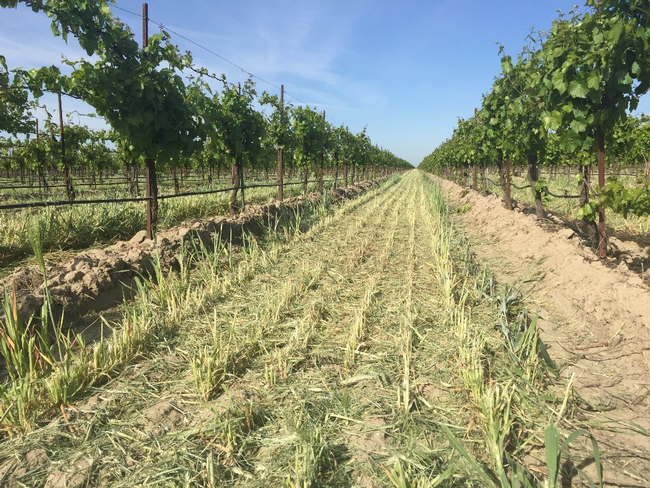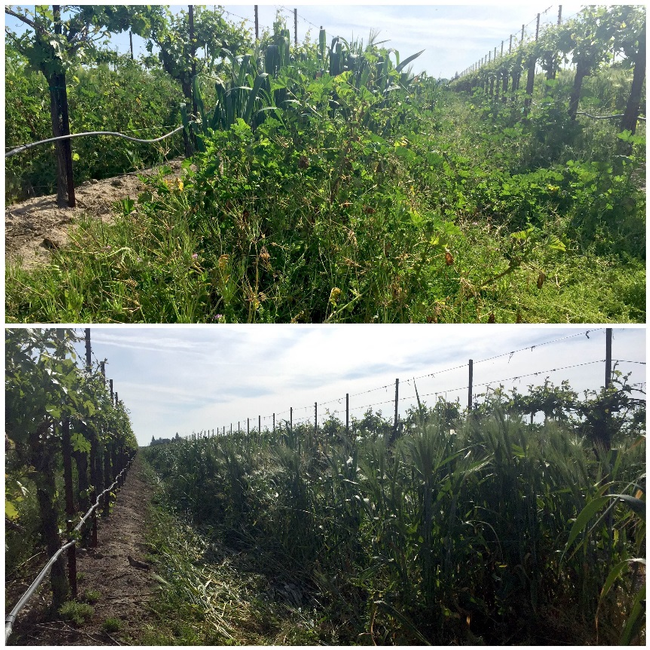Capitalizing on a wet winter, many cover crops established very well in San Joaquin Valley vineyards this year– it has not been uncommon to see stands of barley, mustard, and other species grow taller than 3 feet in vineyard interrows. A robust cover crop planting can offer many benefits to your vineyard site. Winter cereals can break up compaction with their fibrous root systems and legumes can fix nitrogen and contribute to vine nutrition. All cover crop plant species can be used to protect the soil surface from erosion and crusting, improve water infiltration, and provide structure-building organic matter to the soil when mowed or cultivated.


After a wet winter, there were many vineyard floor covers of resident vegetation, comprised mostly of winter annuals that covered vineyard interrows uniformly, behaving much like a seeded cover crop mix. In both cases of resident vegetation cover or a resident vegetation/cover crop mix, traditionally “weedy” species contributed to the role of vineyard floor cover. If mowed and/or incorporated, those weeds will contribute organic matter to the soil and help build soil structure just like that of a seeded cover crop species or mix. Resident vegetation offers some of the same soil building benefits, but at a significant cost savings compared to a seeded cover crop.
As a farm advisor, I was asked the question several times this season – does it matter if the vineyard floor cover is resident vegetation versus a seeded cover crop?
The risks of allowing resident vegetation to establish must be weighed against the saved expense in time and materials not only for the current season, but for your vineyard floor management in years to come. Consider the following for when a stand of resident vegetation can instead turn into an aggressive weed infestation:
- Some species of weeds will always be undesirable.
There are some species of plants that will never be an innocuous part of a cover crop mix. Species like yellow starthistle (Centaurea solstitialis) or stinging and burning nettles can pose a risk to worker safety and any herbicide resistant weeds, like the glyphosate resistant horseweed (Conyza canadensis) that appears in San Joaquin Valley vineyards, pose a large risk to future vineyard production operations. Some weed species should not be tolerated as a part of a cover crop mix. - Weed species may spread.
Weed species that are intentionally allowed in the vineyard intterows may not stay confined to that area. If they spread to the under-vine rows or other parts of the vineyard, additional weed control may be required that season. - Weeds are contributing to the seedbank.
Some weed species may have gone to seed by the time you plan to mow or cultivate your vineyard floor cover. Those seeds are now permanently added to your seed bank and may subsequently affect future years' weed pressure. - Weeds may compete with vines.
You cannot select which resident vegetation species will establish in your vineyard. Purchasing cover crop seed allows for a grower to time the vineyard floor management according to the cover crops known lifecycle, so that it complements the cropping production system. There is no guarantee your weed species will not be actively growing and compete with vines for water and/or nutrients during critical times of the growing season.
Ultimately to judge when resident vegetation has morphed into a deleterious weed population, you need to know exactly which resident vegetation species are present and their stage of growth. Proper identification of weed species within a specific field site is critical before letting resident vegetation species mature with (or instead of) a cover crop. Once the risks for your specific weed population at a vineyard site are understood, you can consider whether the use of a resident vegetation cover can be incorporated into your vineyard floor management.
Lindsay Jordan is the UC Cooperative Extension is the Viticulture Advisor for Madera, Merced, and Mariposa counties.